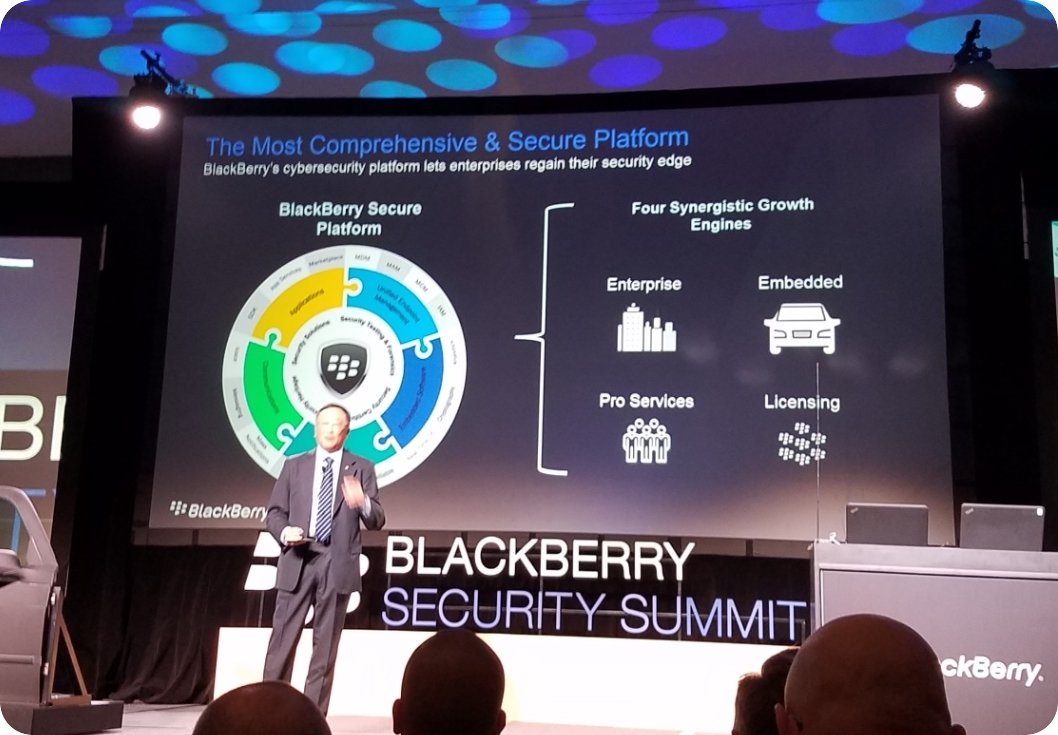Enterprise Mobility & the Connected Worker Blog
BlackBerry Talks the Talk – Still Has Work to Do
BlackBerry continues to move beyond its hardware roots―and speaks that way too.
I had the opportunity to attend BlackBerry’s annual security summit in NYC earlier this week, and left with a different view of the storied vendor.
While BlackBerry’s progress may not be visible, it has assembled a comprehensive security platform and has demonstrated it has fully transitioned from being “that phone company”. But, the company admits it has a perception problem―to many, they are still “that phone company”. That moniker won’t exist much longer in our view, as the company has productized a comprehensive security platform which will continue to be the first choice for state, local and federal government agencies, as well as compliance-intensive organizations. But this is not new: BlackBerry has historically dominated these markets (it services 15 of the G20 countries), and it has a large footprint in the financial services sector. For growth, BlackBerry knows it must amp up its channel strategy and forge new strategic partnerships―this was front and center in CEO John Chen’s keynote that opened the event.
Notable and Quotable: "We are a software and security company, but to create a solid cyber security strategy, we need a robust channel strategy" John Chen CEO, BlackBerry
But the development of its channel isn’t BlackBerry’s only challenge. The companies BlackBerry competes against are often much larger (e.g., IBM, Microsoft, Samsung, and VMware)―in addition to having deeper pockets, these competitors have mature channel/partner strategies, larger sales organizations, well developed industry solutions, and global footprints. BlackBerry has been active with its M&A though; the company has been making moves to position itself for the fight. Not only is BlackBerry sitting on a sizable amount of cash (currently $2.6B, which is considerable given the company’s size), its recent acquisitions―specifically: AtHoc, Encription, Good Technology, QNX and WatchDox―have enabled the company to offer a mix of differentiated and often complementary solutions. Each has also helped in rounding out BlackBerry’s security portfolio and positions the vendor to expand its cybersecurity capabilities while providing service expansion opportunities.

Phones, UEM, IoT and Cars
BlackBerry began licensing its brand to third-party manufacturers such as TCL and BB Merah Putih approximately a year ago, and hasn’t looked back. The strategy has been effective, and has provided the vendor with a means of continuing to service tenured and loyal customers that still want BlackBerry-branded hardware (mostly financial services and government agencies according to our conversations). Like its competitors, BlackBerry has transitioned its EMM solutions to UEM, and has expanded its endpoint management functionality. But, BlackBerry has some catching up to do with its rivals if it wants to truly compete in the next-generation endpoint management space; specifically, on MacOS and Windows 10 management. Citrix, MobileIron, and VMware are all further along in this regard. To compete for this business, BlackBerry will need to work more closely with Apple, Google and Microsoft (certainly not a unique challenge). But Mr. Chen flat out stated: “I don’t want to be an EMM provider”, and that EMM was “a lousy market”. This signals that BlackBerry’s UEM strategy will be geared toward the IoT or Enterprise of Things (EoT); BlackBerry has locked on to the EoT acronym. In this vein, BlackBerry appears to be placing a larger bet with its QNX assets and has been making progress with several automotive manufacturers. The company is also looking to diversify its technology portfolio; its Radar solution, which we wrote about this past September is a good example. Radar targets that transportation industry, and is an asset tracking system which provides real-time visibility into fleet location and performance.
Wrap
While BlackBerry remains well positioned to deliver comprehensive cross-platform mobility solutions, the vendor is unlikely to forge a more strategic relationship with Microsoft and is likely to pivot to the IoT; Given Mr. Chen’s statement on the EMM market. But, BlackBerry still maintains sizeable deployments, has a highly secure solution (due to the vendors’ IP, network assets and NOC element of its UEM solution), and generates significant EMM revenues (>$400M in 2017 according to our estimates). This being said, BlackBerry will not be shutting this business down, and thus will need to improve its integrations with Microsoft, be more aggressive with its roadmap, and continue to build out its mobile app strategy (from both a partner and developer perspective).
Going forward, BlackBerry is very likely sharpen its focus and make notable investments to enhance its Cybersecurity, IoT and automotive market opportunities―these have high-growth potential and are areas that BlackBerry is well suited to compete and win in. The company’s professional service capabilities can be a key differentiator going forward, as the company’s cybersecurity consulting and implementation services capabilities have been significantly enhanced through key acquisitions (based on its cash position, BlackBerry is likely to make additional strategic acquisitions in our view—there is certainly no shortage of innovative/differentiated security-focused vendors to choose from).
View the 2017 Enterprise Mobility & Connected Devices Research Outline to learn more.